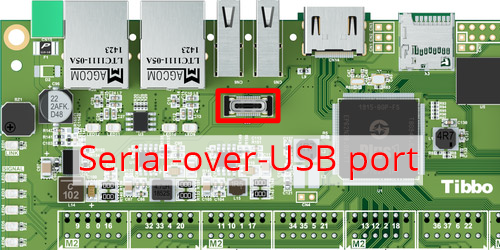Serial Console
The LTPP3(G2) features an embedded serial-over-USB port, which can be used to access a command-line interface. This capability is immensely useful during the initial setup, as well as for maintenance and recovery.
You'll need a cable with at least one USB Type-C connector for use with the embedded serial-over-USB port. If the board is installed in a Size 3 Linux Tibbo Project Box, the top cover — and vibration protection plate, if present — must be removed to access the serial-over-USB port.
On the software side, you'll need a serial console on your computer, such as Tibbo's IO Ninja, which is available for Windows, macOS, and Linux. The connection settings are:
- 115,200bps
- Eight data bits
- No parity
- One stop bit
- Hardware and software flow control should be disabled.
Establishing a Connection

First, connect the cable to the LTPP3(G2)'s serial-over-USB port and then to your computer. If you'll need network connectivity (e.g., to download updates), plug an Ethernet cable into either port of the board.
Before powering on the LTPP3(G2), we recommend that you have your serial console software set up and ready to go to watch for any errors as the device boots up. When you're ready, connect the power supply to the device and start the session in the software if you haven't already. You should immediately see output in the console.
After the operating system finishes loading, you will be presented with a login prompt in the terminal.
The following table details the default usernames and their passwords for each Tibbo Linux distribution.
|
Distribution |
Username |
Password |
|
Yocto |
root |
123 |
|
Ubuntu |
root |
root |
|
ubuntu |
ubuntu |
We strongly recommend that you change the default passwords, regardless of whether you plan to regularly use any of the default accounts.
